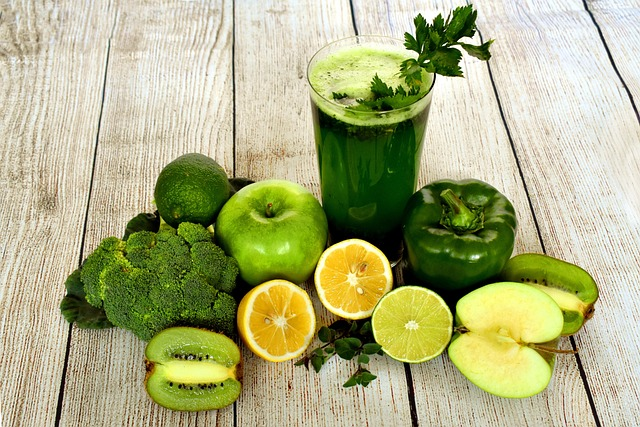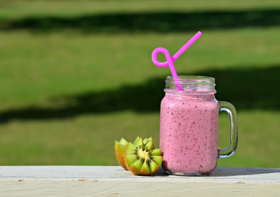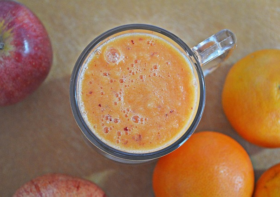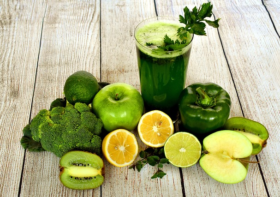21-Day Smoothie Diet Program: Benefits, Tips, and Recipes

- Key Takeaways
- The 21-Day Smoothie Diet Program
- Weighing The Smoothie Diet
- The Nutritional Science
- Is This Diet For You?
- Crafting The Perfect Smoothie
- Beyond The Blender
- Conclusion
- Frequently Asked Questions
- What is the 21-day smoothie diet program?
- Does the smoothie diet provide enough nutrients?
- Can anyone follow the 21-day smoothie diet?
- Will I lose weight on the 21-day smoothie diet?
- What should I put in my smoothies for best results?
- Are there any side effects from following a smoothie diet?
- What happens after the 21 days?
Key Takeaways
- At the heart of the 21-day smoothie diet plan is nutrient-dense liquid meals made from whole ingredients that fuel fat loss and healthier habits.
- The daily meal plan, with its slow return to solids and thoughtful “Flex” days, keeps you motivated and never feels deprived.
- Consistency, hydration, and tracking your progress are key to seeing results and keeping inspired throughout the program.
- Smoothies are a convenient way to increase fruit, vegetable, and fiber intake. Striking the right balance of macronutrients and portion size is paramount to long-term success.
- Make sure to tailor the diet to your specific health needs and talk to your doctor if you have dietary restrictions or medical issues.
- Beyond smoothies, prioritizing hydration, movement and sleep will enhance your wellness and sustain you beyond the program.
21-day smoothie diet meal plan, in which you replace a few meals a day with blended fruit and veggies for three weeks. A lot of people use it to assist with dieting or just to get in more nutrients daily.
They simply select fresh fruits, greens, and seeds for the recipes. With easy prep and straightforward steps, the program accommodates hectic schedules.
The following provides tips, sample recipes, and expectations.
The 21-Day Smoothie Diet Program
The 21-day smoothie diet revolves around swapping out two primary meals a day, typically breakfast and lunch, with nutrient-packed smoothies for 21 days. This low-calorie, high-fiber plan can ignite quick weight loss. At its heart, it’s about eating real food and eliminating processed ingredients, sugars, and empty calories.
For some, this is a substantial change to your daily diet, but it can prepare you for longer-term, healthy transformations.
1. The Structure
Each day, the plan spells out a simple routine: start with a smoothie for breakfast, another for lunch, and a balanced solid meal for dinner. His recipes commonly lean on leafy greens, berries, bananas, and plant-based proteins. Stir in a handful of spinach or a scoop of chia seeds for some fiber to keep you full longer.
P.S. If you’re like me and enjoy a snack between meals, some folks opt for a small apple or raw carrots to keep energy levels steady. Hydration is key, and you are encouraged to drink water, herbal teas, or even coconut water throughout the day.
The last days of the program bring in more solids, getting your body reacclimated to chewing. Following the plan as closely as you can will get you optimal results, as the structure encourages consistent weight loss.
2. The Rules
No processed foods or added sugars; this is essential. It requires you to select whole, easy foods in smoothies and snacks. You should maintain calories within safe recommended bounds, typically 1,200 to 1,500 per day, to achieve weight loss.
Don’t skip a smoothie and don’t eat off-plan or your progress will be hampered. Others journal their meals and weight every day as this keeps them motivated and allows them to identify trends.
3. The Goal
This isn’t about crash dieting or radical detoxing. My motivation is long-term weight loss. Most find themselves energized and healthier at the conclusion of the three weeks.
Results differ, so being realistic in your expectations, such as losing 2 to 4 kgs or cultivating better eating habits, is critical. This plan is a launching pad for sustainable change, not a destination.
4. The “Flex” Day
The “Flex” day is a scheduled cheat, when you indulge in one real meal instead of a smoothie. This keeps the deprivation monster away, so you’re less likely to quit.
Even on Flex day, healthy choices count. Think grilled fish or a big salad, not pizza and fries. Mindful eating on this day keeps you on track without feeling deprived.
5. The Transition
Then, after 21 days, you’re gently weaned back to solid food. Introduce solids gradually. Begin with cooked vegetables or lean meats, then proceed to grains.
Stay with smoothies at breakfast or snack to maintain your results. It’s a great opportunity to look back on what worked, what didn’t, and to set new health goals moving forward.
Weighing The Smoothie Diet
The 21-day smoothie diet lures in its audience with the allure of rapid results and uncomplicated meal plans, yet it boasts evident advantages alongside a few hurdles. Most of them are using it because they’re looking to lose weight or do something healthy by getting in a few more fruits and vegetables each day. Some are concerned about being hungry, others about keeping at it or lacking in major nutrients.
For any body, you must weigh these highs and lows, know your body’s needs and be smart.
|
Benefits |
Potential Downsides |
|---|---|
|
Boosts fruit and vegetable intake |
Can be too low in calories for some (like men) |
|
Supports weight loss (up to 1 lb/week) |
May cause nutrient gaps if not well-planned |
|
Simplifies meals for busy schedules |
Can feel restrictive or unsatisfying |
|
May improve energy and wellness |
Quick rise in fiber can upset digestion |
|
High in fiber, low in calories |
Difficult to follow for longer periods |
Potential Gains
-
Greater Fruit and Veg Intake – Blitzing fruit and veggies daily with smoothies helps people eat more plant foods, supporting a healthy weight and providing the body with vitamins, minerals, and fiber. A bunch of us think it’s simpler to throw spinach, carrots, or berries into a blender than to boil side dishes.
-
Weight loss assistance – To replace two meals a day with a smoothie to reduce calories and lose up to 0.5 kg per week. This gradual loss is healthier and simpler to maintain in the long term.
-
Energy and Wellness – With an increased intake of fiber and nutrients, certain individuals experience enhanced energy, improved skin clarity, and an uplifted mood. For those who feel drained by big meals, smoothies are a refreshing alternative.
-
Meal Convenience – Our busy lives leave little time for meal prep. Smoothies can be prepared in minutes and are portable. They really help maintain good habits even with a busy schedule or when traveling.
Potential Pains
Smoothie diets can be challenging to execute effectively. Not every smoothie adheres to a balanced diet plan, and some may lack essential nutrients like protein, healthy fats, or vitamins. Those who overlook these groups may experience lethargy, weakness, or even light-headedness. To achieve your weight loss goal, it’s crucial to focus on nutritious smoothie recipes that provide the right balance.
For some individuals, sipping meals can feel unusual or unsatisfying. Chewing is an important part of eating, and consuming two smoothies a day might leave you longing for solid food. This could lead to increased snacking or feelings of deprivation, making it harder to stick to a daily smoothie plan.
Sudden increases in fruit and vegetable intake can upset digestion. Overindulging in fiber can result in bloating or cramps, especially if your previous diet was low in plants. Gradually incorporating a green smoothie or detox smoothie into your routine allows your body to adjust more comfortably.
Everyone has unique dietary needs. For instance, men often require a higher calorie intake than what a strict smoothie diet can provide. When snacking, opt for smart choices like nuts, seeds, or low-sugar fruits instead of sugary protein bars, which can derail your healthy eating habits.
As with any significant dietary change, it’s wise to consult a physician or dietitian first. They can help tailor your smoothie diet plan to meet your nutritional needs, identify potential risks, and support you in overcoming any challenges that may arise along your wellness journey.
The Nutritional Science

Smoothies can be an intelligent source of must-have nutrients during a calorie deficit, which is the fundamental goal of many smoothie diet plans. Understanding the nutritional information behind the ingredients allows you to craft weight loss smoothies that delight and nourish your body. Every ingredient carries its own combination of macronutrients and micronutrients, and your decisions can impact everything from your energy level to your satiety.
|
Ingredient |
Carbs (g/100g) |
Protein (g/100g) |
Fat (g/100g) |
Key Micronutrients |
|---|---|---|---|---|
|
Banana |
23 |
1 |
0.3 |
Vitamin B6, Potassium, Vitamin C |
|
Spinach |
3.6 |
2.9 |
0.4 |
Iron, Vitamin K, Folate |
|
Greek Yogurt |
4 |
10 |
0.4 |
Calcium, Vitamin B12, Phosphorus |
|
Almonds |
22 |
21 |
49 |
Vitamin E, Magnesium, Manganese |
|
Blueberries |
14 |
0.7 |
0.3 |
Vitamin C, Vitamin K, Manganese |
|
Avocado |
9 |
2 |
15 |
Vitamin E, Folate, Potassium |
|
Chia Seeds |
42 |
17 |
31 |
Calcium, Iron, Omega-3s |
Macronutrients
Carbohydrates, proteins and fats all have a role to play in every smoothie. Fruits such as bananas and berries provide fast-acting carb fuel. Protein from Greek yogurt, tofu or nuts repairs muscles and staves off hunger longer.
Avocado, nut or seed fats will satiate you and assist your body in using vitamins. Balance is critical. Too many carbs without protein or fat will leave you hungry in no time. A solid smoothie, for example, could combine frozen berries, a spoon of peanut butter, and a scoop of yogurt.
Whole food sources are ideal. Choose nuts, seeds, and real fruit over powders or syrups. Portion size is important as well. Overstuffing with fruit or a lot of nut butter can sneak in those calories, and they add up quickly.
Micronutrients
Vitamins and minerals in smoothies fortify immune function, bone health, etc. A combination of greens, fruit, and seeds provides the broadest nutritional spectrum. Spinach provides iron and vitamin K. Berries provide vitamin C and antioxidants.
Rotating your produce with each blend helps cover more micronutrients. Opting for whatever is in season can enhance flavor and vitamin levels. Think for instance, citrus in winter and berries in summer. Micronutrients might get less attention than carbs or protein, but they are important for lifelong health.
Fiber’s Role
- Slows digestion, keeps you full longer
- Feeds healthy gut bacteria
- Helps keep blood sugar steady
- Supports regular digestion
Nutritionally speaking, you can add chia seeds, oats, or whole apples to increase the fiber. Fiber helps keep blood sugar from spiking after a meal, which translates into less cravings. Whole fruits and veggies beat out juice for this.
Fiber gets you towards your weight goals by filling you up and is fantastic for gut health by keeping things moving and feeding the good bacteria in your system.
Is This Diet For You?
At its core, the 21-day smoothie diet centers on replacing regular meals with nutrient-dense smoothies filled with fruits, vegetables, and some protein. It holds out an easy path to plant-focused eating and calorie reduction, but it’s not for everyone. Whether this diet fits your lifestyle comes down to your current health goals, your habits when it comes to your day-to-day eating, and how you prefer to eat.
Self-reflection is crucial. Not everyone will like the structure or calorie restrictions, particularly those with specialized nutritional needs or health issues. Taking the time to consider your lifestyle, energy needs, and preferences will help you understand if dedicating three weeks to smoothies is really a doable commitment for you.
Ideal Candidates
- People seeking quick, structured dietary changes
- Busy individuals with little time for meal prep
- Those wanting to eat more fruits and vegetables
- Individuals aiming for short-term weight loss
- People who enjoy smoothies and blended meals
- Individuals without chronic health conditions or special nutrient needs
With busy schedules, meals get missed or are from drive-thrus. The smoothie diet can slot right in, requiring less time than cooking while simplifying nutrient consumption on the go. If your mornings are crazy or lunch breaks are tight, grabbing a pre-made smoothie can be a huge time and stress saver.
Some remain on this diet to increase their intake of greens and fruits. For instance, blending spinach, mango, and banana into your breakfast is an easy beginning. If you know you fall short on your veggie intake, you might find this easier to mix than to make.
Format counts. This is a 21-day diet, a set plan for a set time, so it’s best if you’re prepared for a routine and don’t mind missing out on normal solid meals. Questioning whether you’ll miss chewing or yearn for variety can help you determine if this plan fits your lifestyle.
Health Cautions
Careful, people with special diets or health conditions! The smoothie diet might not provide enough calories for adults, particularly if you exercise or have a labor-intensive occupation. Too little can cause fatigue, headaches, nausea, or hunger.
If you’re pregnant or breastfeeding, the diet could be missing some critical nutrients needed by both you and your baby. Others might feel the plan is too restrictive and struggle to adhere or feel deprived.
It’s a good idea to consult a healthcare professional prior to beginning, particularly if you have any chronic conditions, are on medication, or have a past of disordered eating. Even robust adults should keep tabs on how they feel, as digestive discomfort or micronutrient deficiencies can arise.
For instance, swapping out every meal for a smoothie can make it more difficult to get sufficient fiber, iron, or healthy fats unless you take the time to meticulously plan your ingredients. Just watching for symptoms of discomfort, monitoring your energy, and ensuring you’re still hitting protein and healthy fats each day can keep things in check.
There hasn’t yet been much research on the long-term effects of this diet. A more customized plan, like switching up just one meal a day instead of all, might be a better fit for some.
Crafting The Perfect Smoothie
Designing a smoothie diet plan for the 21-day program goes beyond just flavor; it involves combining the right foods for a balanced meal while managing calorie intake and meeting your nutrient targets. A healthy smoothie, such as a green smoothie recipe, incorporates delicious fruits, nutritious veggies, beneficial fats, and energizing protein. Using a measuring cup helps prevent unintentional over-pouring, which can quickly lead to exceeding your daily calorie goal.
Focusing on nutrient-dense foods and replacing sugary beverages with weight loss smoothies and whole, fresh alternatives ensures you stay on track with your wellness goals.
The Base
Think of the base as the backbone of any smoothie. Choose any base that provides both taste and nutrition. Unsweetened almond milk, coconut water, and oat milk pack a punch when it comes to creaminess. Water is plain, virtually calorie-free, and hydrates you.
Coconut water adds a subtle sweetness and tons of electrolytes without too much sugar. Low-sugar varieties keep total calories and carbs down, which is essential for weight loss or steady energy. The right base creates the texture vibe, creamy and not too thick or thin.
Lots of people use almond milk, but soy works or even plain water; it is a matter of taste and dietary requirements.
The Protein
Protein is essential in a smoothie diet plan as it helps keep you full throughout the morning. Incorporating protein-rich ingredients aids in weight loss by promoting muscle strength and satiety. While protein powders are convenient, using Greek yogurt and nut butters can also enhance the nutritional value of your smoothies.
I like to add some plain, low-fat Greek yogurt for a smooth, mild flavor and extra protein. Depending on your activity level, you can adjust the quantity; for exercise enthusiasts, an extra handful may be necessary. For others, a spoonful of nut butter or a scoop of protein powder suffices.
Mixing up your protein sources can keep things interesting. Keep in mind protein gives smoothies staying power and helps prevent cravings later in the day.
The Fat
Healthy fats add flavor, richness, and help your body absorb vitamins. Avocado mixes in for a smooth base and nuts and seeds contribute crispness and good oils. Portion control counts.
Fats contain more calories per gram than carbs or protein, so use a tablespoon of nut butter or a quarter of an avocado. Chia or flax seeds are simple omega-3 add-ins. Fats curb hunger and keep you full longer, making your smoothie more satiating.
The Greens
Greens boost health without cramming in additional calories. Spinach, kale, and Swiss chard are favorites. Test out a handful of spinach; it purees well and its flavor is very complementary, particularly when paired with banana or mango.
Mixing greens with sweet fruits masks the flavors if you’re not a fan. Begin with a little and work your way up. Greens add fiber, which keeps you full and pack in nutrients to reduce your risk of disease.
The Flavor
Fruit, spices and natural sweeteners make each smoothie new. Bananas, berries and mango sweeten it and give it color. Hints of spices such as cinnamon or ginger can enhance the flavor without adding sugar.
Experiment with fruit for sweetness or a date or two for a denser flavor. Maintain sugar levels low by selecting unsweetened toppings and avoiding syrups. Interchanging fruits and spices each time keeps the diet fresh and not so much like a routine.
Beyond The Blender

A 21-day smoothie diet program is about way more than just blending fruits and veggies. Smoothies may increase fruit and vegetable intake, but the real gains occur with a balanced approach. Wellness isn’t just what’s in your glass—it’s about tending to the entire self.
Hydration, movement, and sleep all work together to encourage sustainable health and weight shifts.
Hydration
Hydration is important during a smoothie diet. Smoothies may make you less thirsty, but they don’t restore water. Hydration aids digestion, prevents energy highs and lows, and facilitates the body’s waste cleansing.
Dehydration can stall metabolism, give you headaches, and even make you feel more hungry than you are. Shoot for at least 2 liters per day, more if you’re active or in a warm climate. Others find it useful to keep a water bottle nearby or set reminders.
Water is the easiest to track because it really can’t be more complicated than crossing out cups on a page or on a phone app. This little step helps support your body while you’re changing habits, making you feel more awake and less likely to confuse thirst with hunger.
Movement
Fitting in daily movement provides a boost to your diet plan. Exercise burns calories and keeps muscles strong. You don’t have to join a gym or run marathons.
Even a brisk 30-minute walk, cycle, or some gentle yoga can help. The key is to choose things you like, so it feels less like a task and more like nourishment. Blending shut-eye with your smoothie schedule can help you lose weight and improve your mood and sleep.
Others claim to be inspired to eat clean all day long once movement is on the menu. Get creative – try some dancing or swimming, or even take the stairs more often. Regularity is the true secret, not intensity or length.
Sleep
Sleep is underrated and plays a crucial role in a balanced diet. Lousy sleep not only hinders your weight loss smoothies efforts but also increases cravings for sugar. Adequate sleep helps regulate hunger, fuels energy, and allows your body to repair itself after a long day.
Attempt to retire and arise at the same time every day. Restrict screen time before bedtime and maintain a cool, dark room environment. Others discover that reading or soothing music relaxes them.
Good sleep supports your kitchen and workout endeavors, ultimately contributing to your overall wellness goals and helping you feel great throughout the day.
Conclusion
The 21 day smoothie diet can create real change when you follow it. A lot of people report they feel leaner, sleep better, and even have more time on hectic mornings. Fresh fruit, greens, and nuts bring flavor and vibrance to each cup. You get a reprieve from heavy eating and discover fresh ways of being nourished. A friend of mine gave this plan a shot and told me that combining new flavors became exciting again at breakfast. There are some days that are a real struggle. Support from others really helps. Seek out small victories and monitor. Something to kick start your day or just plain easy delicious meals. That’s where the smoothie diet might just fit in. Post your own tips or swaps and find out what new blends you like best.
Frequently Asked Questions
What is the 21-day smoothie diet program?
The 21-day smoothie diet plan is a crash meal plan that substitutes a few daily meals with nutrient-dense weight loss smoothies. It is designed to shed pounds and boost produce consumption.
Does the smoothie diet provide enough nutrients?
Yes, if you use different ingredients in your smoothie diet plan. Incorporate some veggies, fruits, and protein sources for balanced nutrition during the diet.
Can anyone follow the 21-day smoothie diet?
Any healthy adult should be able to try a smoothie diet plan. Those with medical conditions and special dietary needs should consult a doctor first.
Will I lose weight on the 21-day smoothie diet?
Most lose weight on the smoothie diet plan primarily because they are consuming fewer calories and more nutrition.
What should I put in my smoothies for best results?
Mix leafy greens, fruits, and a source of protein such as yogurt or tofu to create a green smoothie that supports your weight loss goals and overall diet quality.
Are there any side effects from following a smoothie diet?
Some will experience hunger or fatigue initially, but these feelings tend to subside as your system adapts to the smoothie diet plan. As usual, listen to your body and adjust your daily smoothie plan accordingly.
What happens after the 21 days?
After 21 days, switch to a nutritionally balanced, whole foods diet and incorporate weight loss smoothies as a delicious and nutritious part of your healthy eating lifestyle.



Leave a Reply